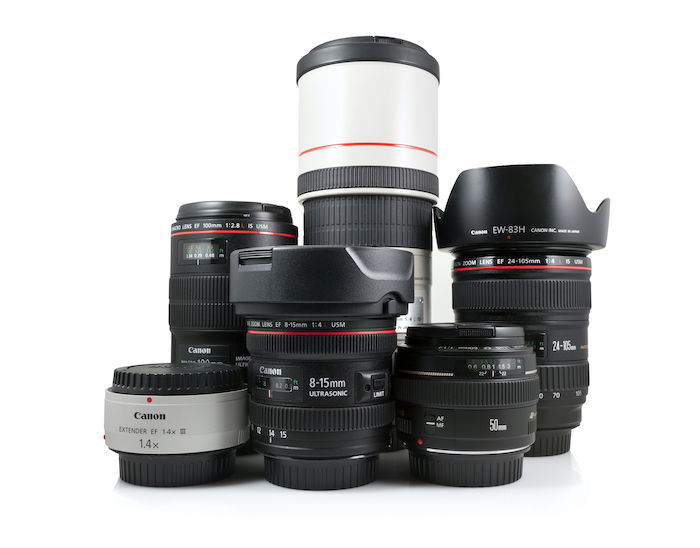These may seem like hieroglyphics, but today we will decipher these for you. In particular, we will be looking at all abbreviations associated with Canon lenses. By the end of this article, you will be familiar with all the Canon lens abbreviations from ASC to USM.
What are Canon Lens Abbreviations?
Lens abbreviations are the set of initials that you can find after the lens’s focal point and its aperture in its name. These initials are also seen before the name and elsewhere on a canon body. Let us take a quick look at an example of what we will see on a Canon lens. The Canon EF 28-300mm f/3.5-5.6L IS USM. The first bits of information that are easy to spot are the brand name, the focal length, and the aperture. These are the most valuable bits of information as you will typically have a focal range in mind when shopping for a new lens. In this example, we come across EF, L, IS, and USM. I can tell this is a luxury lens made for digital cameras with image stabilization and an ultrasonic motor for fast and quiet autofocusing. Being familiar with lens abbreviations isn’t just beneficial when buying a lens. They will also help you understand lens technology and the developing trends in lens photography. This will become useful when encountering new gear that you haven’t used before. If you are aware of the features of the lens, you can adjust the way you shoot. For instance, if the lens has image stabilization (IS), you have the option to shoot with longer shutter speeds. Canon lenses will always contain some of these abbreviations as they are a quick way to show off their features. Let’s now take a deeper dive into a list I compiled with all the Canon lens abbreviations you’ll come across.
Canon Lens Abbreviations
ASC – Air (A) Sphere (S) Coating (C) is a special type of coating that was introduced in 2014. ASC heavily reduces lens flare and ghosting. Lenses cannot usually prevent this with conventional vapour-deposited coatings. You will not find this written on Canon lenses but inside the manual. AFD – Arc (A) Form (F) Drive (D) is the name of Canon’s first autofocus motor technology. If you come across this, the lens will be old as the current Canon lenses have newer autofocusing motors. BR – Blue (B) Spectrum Refractive (R) was first seen on a Canon lens in 2015. It is a lens element that corrects for color fringing. The BR lens element is made of organic optical material. This is combined with a concave and convex lens to help focus visible light to a single point. CINE-SERVO – Cine-Servo lenses are special CN-E that include removable hand zoom controllers. CN-E – Cinema (CN) EOS (E) lenses are part of Canon’s professional cinematography range. Compact Macro – There is currently only one compact macro lens, the 50mm f/2.5. Compact microlenses are much smaller than other macro lenses and are less powerful. Compact Servo – This will be a Canon lens that is part of the cinematography range between EOS lenses and the more expensive CN-E lenses. DO – Diffractive (D) Optic (O) technology allows for a much smaller number of glass elements inside a lens. This results in a smaller and lighter lens made to the same standard as Canons L lenses. You can easily spot these lenses with a green ring around the lens barrel. DS – Defocus (D) Smoothing (S) is a lens with a built-in apodisation filter. This lens element helps smooth out the out-of-focus areas in an image.
EF Mount – Electro (E) Focus (F). A lens with an EF mount will attach to any Canon EOS camera. This can range through film, cropped sensors, and full frame cameras. It is their trademark mount that Canon first introduced in 1987. EF lenses are considered to be Canons standard lens range. EF-M Mount – This mounting system is for EOS M mirrorless cameras. These EF lenses are small and are designed only to fit APS-C sensors. It is a limited range and will soon be obsolete due to Canons RF range. EF-S Mount – EF-S lenses are EF lenses with an S that stands for Small image circle. EF-S lenses will only cover APS-C-sized filters like the EF-M mount. FD Mount – The FD mount signifies this lens is made for 35mm cameras. These mounts will only take manual focus lenses. They will not fit EOS cameras unless you have an adaptor. FDn Mount – These ‘new’ FD mounts are exactly the same as FD mount lenses but have an SSC (Super Spectra Coating). These lenses will also only have manual focus capabilities. I, II, III – Roman numerals signify the generation this particular lens belongs to. The greater the number, the newer the generation of lenses it is a part of. IS – Image (I) Stabilization (S) is a technology that uses a system of gyros to counteract your own movements to allow for less camera shake. This will enable you to take images with a longer shutter speed without worrying about the sharpness of the picture. KAS S – KAS S lenses are CN-E lenses with a servo controller for smooth zoom, iris, and focus control. L – Luxury (L) lenses are Canons’ top-of-the-line optics that are clearly identified by their red ring around the lens barrel. These lenses are found both in EF and RF lens lines. All L lenses will feature an ultrasonic motor, great weather sealing capabilities, and great build quality. So, if you buy an L lens, you know you’re getting the best of the best! Macro – Macro lenses are designed for close-up photography. These lenses will be able to focus while shooting much closer to your subject than regular lenses. MP-E – Macro (M) Photo (P) EF (E). There is only one lens in the MP-E range and it is the MP-E 65mm f/2.8. A unique lens that allows for super macro photos, allowing for 5x more magnification than regular macro lenses. This lens does not have a focus ring. Instead, you will need to focus by physically moving the lens. PL Mount – You will only find Positive (P) Lock (L) mounts on Canons cine lens range. In particular, you will only see this on their higher-end cine lenses. The PL mount is an industry-standard mount made for cinematography. PZ – The Power (P) Zoom (Z) adaptor is a detachable accessory designed for particular lenses. It is a zoom lever that will allow you to produce incredibly smooth zooming. RF Mount – The RF mount is made for Canon’s mirrorless range of cameras. The RF mount is the newest lens mount and will only fit on Canons mirrorless cameras unless there is an adaptor. The RF mount has a shorter flange depth, allowing the lens elements to be closer to the sensor.
SC – Spectra (S) Coating (C) is a lens coating found on Canons FD mount lenses. This coating is applied to the outer lens elements to increase contrast and minimise reflections and lens flare. SSC – Super (S) Spectra (S) Coating (C) is similar to SC but is used on more expensive lenses. Neither of these coatings are used on new Canon lenses as they will all have complex multilayer coatings that are more impactful. STM – The Stepper (ST) Motor (M) is a feature that provides faster, quieter, and more accurate focusing. This is particularly helpful for video as sometimes you can hear the focusing motor in certain videos. STM is also a lot more accurate than manual focus. SWC – Sub-Wavelength (SW) Coating (C) is the successor to SC and SSC coatings. This coating is beneficial for reducing flare and ghosting. TS-E – Tilt (T) Shift (S) lenses allow you to move around the plane of focus to achieve new aesthetics. This is normally used for architectural photography as you will keep the building straight without having the lines converge. UD – Ultra-low (U) Dispersion (D) is a type of glass found inside a Canon lens. This glass has a low refractive index and low dispersion. Its performance is significantly better than ordinary optical glass. USM – A Ultrasonic (US) Motor (M) is now a feature in most Canons lenses. This motor allows for faster and quieter focusing. These lenses will not be quieter than the STM motors, though. Micro USM – Micro USM is what you think it is, a smaller version of the USM. It is cheaper, louder, and slower than a USM lens. This lens will also not allow you to override autofocus.
Conclusion
After looking at all these Canon lens abbreviations, we can see why Canon has put these in place. Even if you worked for Canon, you could become constantly confused by the abbreviations you will encounter. We don’t imagine you’ll keep all this information retained, so be sure to bookmark this page to come back in the future. It will be handy, especially when looking for a new Canon lens to buy! Check out our Photography for Beginners course to learn how to best use your new Canon lens!






